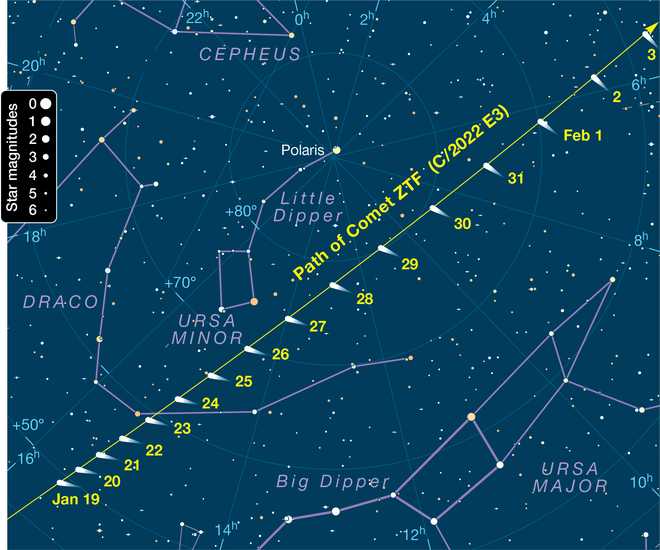A recently discovered comet will make its closest approach to Earth this week. The comet, named ZTF (C/2022 E3), can be seen by sky watchers with good binoculars or binoculars. Comet ZTF lies between the Big and Little Dipper in the northern sky on the last two nights of January. . According to Sky and Telescope in Cambridge, the best times to see the comet are early in the morning, after the moon has set. Contrary to many reports, the comet does not appear green to most people, says the head of Sky and Telescope. Editor, Kelly Beatty.”Our eyes can’t see color very well at night,” Beatty added, adding, “Green is not uncommon in comets.” Beatty cautions night sky watchers not to set their expectations too high when trying to see. Comet ZTF.” Strong moonlight and light pollution can be “comet killers” because the comet is a fuzzy ball,” Beatty said. Feb. A bright moon interferes with viewing as the moon approaches its full phase between 3-5. . Then, the best viewing times are after sunset, before moonrise, between February 6-22. Video below: A sequence of lights seen in the sky. Video Below: New ‘Space Adventure’ High-Speed Exhibit Releases Video Below: Meet MIT Astrophysicist Who Can Use Web Telescope
A recently discovered comet will make its closest approach to Earth this week. Named ZTF (C/2022 E3), the comet can be seen by sky watchers with the help of good binoculars or binoculars.
Comet ZTF lies between the Big and Little Dipper in the northern sky during the last two nights of January. According to the Cambridge-based Institute, the best times to see the comet are early in the morning, after the moon has set. Sky and telescope.
According to Kelly Beatty, editor-in-chief of Sky and Telescope, contrary to many reports, the comet does not appear green to most people.
“Our eyes can’t see color very well at night,” Beatty added, adding, “A green color is not uncommon with comets.”
Beatty cautions night sky watchers not to set high expectations when trying to see comet ZTF.
“Strong moonlight and light pollution can be ‘comet killers’ because a comet is a fuzzy ball,” Beatty said.
A bright moon will interfere with viewing as the moon moves towards its full phase between February 3-5. Then, after sunset, before the moon rises, the best viewing time is between February 6-22.
Video below: A sequence of lights seen in the sky over Mass.
Video below: New ‘Space Adventure’ immersive exhibit launched
Video below: Meet an MIT astrophysicist who can use the Webb telescope
